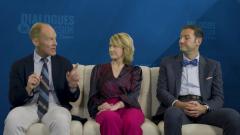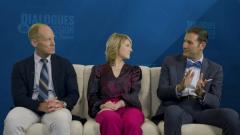
Clinical Insights: Second Case Analysis of MDD
Clinicians expand their discussion with a second patient case, highlighting similarities and differences between cases, and particular treatment algorithms that may be helpful.
Episodes in this series

Transcript
Gus Alva, MD, DFAPA: Let me shift to a different case now. So we’ve got a 32-year-old woman. She’s had a history of major depressive disorder, contrary to our previous gentleman. She was diagnosed in her early 20s. She’s experienced multiple depressive episodes with some periods of remission. She’s tried various antidepressive medications over the years, but it’s not achieved sustained remission. Presently, she’s reporting persistently low mood, loss of interest in activities that she previously enjoyed, changes in appetite [and] sleep patterns, difficulty concentrating, feelings of hopelessness. She states that these symptoms have been present for several months, significantly impacting her daily life, work, and relationships. Her previous treatment history includes the use of SSRIs [selective serotonin reuptake inhibitors], SNRIs [serotonin-norepinephrine reuptake inhibitors], for approximately 6 years starting, as we mentioned, in her early 20s. Initially, she responded well and experienced remission from depressive symptoms for a period of about 2 years. She’s also engaged in regular psychotherapy, [which is] something we didn’t necessarily have embedded with the previous case, which helped her develop coping strategies and improve her overall well-being. Remission has been followed by recurrence of depression, despite treatment adherence, so tying back to [Craig’s] previous themes. Her providers have adjusted treatment dosage [by] utilizing adjunctive therapies such as atypical antipsychotics. Some relief noted, but still having low mood and fatigue. With that in mind, would you approach this particular patient a little differently than our previous case? Erin, let’s start with you.
Erin Crown, MHS, PA-C: Well, while in the previous case, I would not have given consideration to another SSRI given that’s what he was on, I might have considered an antidepressant of a different class that maybe wasn’t a glutamate-modulating antidepressant, and it would have been appropriate, maybe a bupropion or something of that nature. But with this [case], she’s already been through the gamut, right? Technically, she meets criteria for treatment-resistant depression because she has had so many trials of antidepressants of a variety of classes plus augmentations. For this person, I would certainly not be considering monoaminergic utilization in her drug therapy, but I would probably educate and offer this individual a choice between esketamine or the [dextromethorphan-bupropion] glutamate-modulating agent and help her to understand the differences, the complications related to access and things of that nature. That’s kind of how I would approach it. But I’m really glad that she’s in psychotherapy. One of the things that we haven’t really talked about is how, when people do get well, we’ve talked a lot about remission and sustained remission with these glutamate-modulating drugs that we have now. But what we’ve not talked about is the really important aspect of therapy for them just to then begin to recognize normal emotion. Sometimes, this is a population of people that when they do enter remission and they stay there, then when they have what we would consider an event in their life that it’s normal to be sad about, they become very, very afraid that the depression is back and that they’re relapsing, and it becomes this overwhelming thing that can begin to spiral. So I’m delighted to hear she’s in psychotherapy.
Gus Alva, MD, DFAPA: Wonderful practical points. Craig, additional insight regarding the case?
Craig Chepke, MD, DFAPA: I think a lot of the same things that Erin mentioned. I think using the shared decision-making approach is definitely what we should do for everybody. And usually with that, we’ll highlight what we think. Here’s kind of how I would put them, but I want to lay out all the options. I would lean toward [esketamine] with this person, given the number of trials, the severity, the difficulty in maintaining the response in remission. There have been recent data released for esketamine showing [response for] as long as 6 years, but the average length of that long-term study, the patients were in it for about 4.5 years with the median time, so [it was over] a very long term that the response was sustained. But there’s another option, which hasn’t been studied…potentially starting someone with esketamine and transitioning them to dextromethorphan-bupropion. We don’t have clinical trial data for that, but that’s something that in my clinical practice I’ve seen has been beneficial for some patients.
Greg Mattingly, MD: First of all, let me compliment her clinician. I think this is a good clinician, right? He’s tried multiple medications. He’s bonded to the patient, who’s stuck with him. He’s engaged them in psychotherapy. One of the things I would stress to a patient is [that] relapses can happen. That doesn’t mean we’ve thrown everything out. We’re going to watch for those, we’re going to treat those, here are the signs and symptoms of those. I have a lot of people who have a mild relapse this time of year as we head into winter. That doesn’t mean all hope is lost. So I’ll focus on those patients, and I want you to be mindful, right? That, listen, you can get well. When people do get well, I’ll say, OK, take a snapshot of this. I’m going to stick this in your brain, because when and if the depression comes back, I need to remember this. Remember, we can get you back to this place. I think that mindfulness component, the one thing we hadn’t thrown in yet was exercise. The importance of exercise, which turns on neural growth factors. Exercise plus medicine works better than either one alone. And exercise plus therapy plus medicines has been shown to double remission rates versus just medicines and therapy. I’m like you [all], I think we’re thinking about glutamate approaches. The other thing I would think about is TMS [transcranial magnetic stimulation]. We didn’t talk about neuromodulation with this patient. So, she would be esketamine. She would be the combination of bupropion [and] dextromethorphan or TMS. Then mindfulness-based therapy and then exercise would be the things I’d think about.
Gus Alva, MD, DFAPA: I’d love the fact that you’re being very practical with that. Because I think that that’s what our audience needs. I think also the point of mindfulness is something that does actually help enhance glutamatergic tone of the brain. You touched on exercise. That is certainly something that will make you feel invigorated and calm at the same time, which means that GABA [γ-aminobutyric acid]-glutamate [relationship] is happening—
Craig Chepke, MD, DFAPA: It turns on neuroplasticity and BDNF [brain-derived neurotrophic factor].
Gus Alva, MD, DFAPA: And that’s very important. One thing that we can’t fail to omit is appropriate hydration, [and] making sure that people are sheltering the time in which they sleep. But I too would commend, again, the thoughtfulness associated with the clinician who has been tracking this young woman, because she’s early in the course of her life, and we want to make sure that she’s thriving, and that she is best protected from having additional problems. And part of the theme that we’ve been touching on the entire time that we’ve been together is really trying to get people better, faster. They walk in, they want to feel better yesterday. They don’t want to wait the typical 6- to 8-week time frame that we generally set up for them, which has been a construct of the instruments that we’ve had up to this point. We now have sharper instruments that can [maybe] excise the problem at a quicker pace, so that’s wonderful.
Transcript was AI-generated and edited for clarity.
Newsletter
Receive trusted psychiatric news, expert analysis, and clinical insights — subscribe today to support your practice and your patients.




























